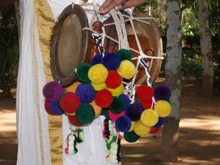Sopanasangeetham

Sopanasangeetham is a musical art form performed with the accompaniment of Idaikka especially in the temples of Kerala. Sopanasangeetham is recited only when the inner sanctum sanctorum of the temple is closed for customary ceremonial offerings to gods and goddesses. Only the Maaraar and Pothuval community had the privilege of doing this. It is also sung with the accompaniment of another musical instrument named Chengila. It is customary to sing this song, from the time the inner sanctum sanctorum closes to the time it opens, in praise of the respective god or goddesses, the temple is dedicated to. The lyrics are either in Malayalam or Sanskrit. The 24 songs in Gita Govindam, which is known to be India’s first light music composition.
In the past there existed four different castes in Kerala – Brahmin, Kshathriya, Vaisya and Sudhra. The Maaraar and Pothuvaal community belonged to the Sudhras, lowest in status compared to the other castes. They used to sing the Sopanasangeetham from inside the temple. It was Njeralathu Raamapothuvaal who made the most important and notable contribution towards this genre of music. He rebelled against the beliefs, breaking Sopanasangeetham free from the shackles of customary rules and started performing anywhere he liked. This was done with the notion that he ardently believed that the ‘God is omnipresent’. And thus he instituted a version of the Sopanasangeetham that he sang outside the temple as Bhajanam or prayer and popularized it as the Janahitha Sopaanam (the sopaanam according to the interest of the public) of the masses and the common man. Today, Njeralathu Harigovindan, the sixth son of Njeralath Raamappothuvaal is the only singer of Sopaanasangeetham who adopts this method in Kerala. His brother Njeralath Aanandha Sivaraaman is the only person in Kerala who produces an Idaikka in its real structural and complete form.
In the past there existed four different castes in Kerala – Brahmin, Kshathriya, Vaisya and Sudhra. The Maaraar and Pothuvaal community belonged to the Sudhras, lowest in status compared to the other castes. They used to sing the Sopanasangeetham from inside the temple. It was Njeralathu Raamapothuvaal who made the most important and notable contribution towards this genre of music. He rebelled against the beliefs, breaking Sopanasangeetham free from the shackles of customary rules and started performing anywhere he liked. This was done with the notion that he ardently believed that the ‘God is omnipresent’. And thus he instituted a version of the Sopanasangeetham that he sang outside the temple as Bhajanam or prayer and popularized it as the Janahitha Sopaanam (the sopaanam according to the interest of the public) of the masses and the common man. Today, Njeralathu Harigovindan, the sixth son of Njeralath Raamappothuvaal is the only singer of Sopaanasangeetham who adopts this method in Kerala. His brother Njeralath Aanandha Sivaraaman is the only person in Kerala who produces an Idaikka in its real structural and complete form.
